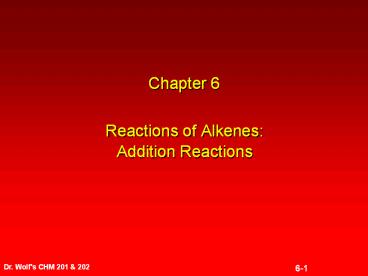Reactions of Alkenes: Addition Reactions
1 / 56
Title: Reactions of Alkenes: Addition Reactions
1
Chapter 6
- Reactions of AlkenesAddition Reactions
2
Reactions of Alkenes
- The characteristic reaction of alkenes is
addition to the double bond.
AB
3
6.1Hydrogenation of Alkenes
4
Hydrogenation of ethylene
?
?
?
?
HH
- exothermic ?H 136 kJ/mol
- catalyzed by finely divided Pt, Pd, Rh, Ni
5
Example
H2, Pt
(73)
6
Problem 6.1
- What three alkenes yield 2-methylbutane on
catalytic hydrogenation?
7
Problem 6.1
- What three alkenes yield 2-methylbutane on
catalytic hydrogenation?
H2, Pt
8
Mechanism of catalytic hydrogenation.Figure 6.1
9
Mechanism of catalytic hydrogenation.Figure 6.1
B
Y
C
C
A
X
10
Mechanism of catalytic hydrogenation.Figure 6.1
11
Mechanism of catalytic hydrogenation.Figure 6.1
B
Y
A
X
C
C
12
Mechanism of catalytic hydrogenation.Figure 6.1
13
Mechanism of catalytic hydrogenation.Figure 6.1
14
6.2Heats of Hydrogenation
- can be used to measure relative stability of
isomeric alkenes - correlation with structure is same as when heats
of combustion are measured
15
126
119
115
CH3CH2CH2CH3
16
Heats of Hydrogenation (kJ/mol)
- Ethylene 136
- Monosubstituted 125-126
- cis-Disubstituted 117-119
- trans-Disubstituted 114-115
- Terminally disubstituted 116-117
- Trisubstituted 112
- Tetrasubstituted 110
17
Problem 6.2
Match each alkene of Problem 6.1 with its
correctheat of hydrogenation.
18
Problem 6.2
Match each alkene of Problem 6.1 with its
correctheat of hydrogenation.
highest heat ofhydrogenationleast stable isomer
lowest heat ofhydrogenationmost stable isomer
19
6.3Stereochemistry of Alkene Hydrogenation
20
Two spatial (stereochemical) aspects ofalkene
hydrogenation
- syn addition of both H atoms to double bond
- hydrogenation is stereoselective, corresponding
to addition to less crowded face of double bond
21
syn-Addition versus anti-Addition
syn addition
anti addition
22
Example of syn-Addition
H
CO2CH3
CO2CH3
H
(100)
23
Stereoselectivity
- A reaction in which a single starting
materialcan give two or more stereoisomeric
productsbut yields one of them in greater
amounts thanthe other (or even to the exclusion
of the other)is said to be stereoselective.
24
Example ofstereoselective reaction
H2, cat
Both productscorrespond tosyn additionof H2.
25
Example ofstereoselective reaction
H2, cat
But only thisone is formed.
26
Example ofstereoselective reaction
H2, cat
Top face of doublebond blocked bythis methyl
group
27
Example ofstereoselective reaction
H2, cat
H2 adds to bottom face of double bond.
28
6.4Electrophilic Addition of Hydrogen Halides
to Alkenes
29
General equation for electrophilic addition
??
?
EY
30
When EY is a hydrogen halide
??
?
HX
31
Example
CH3CH2
CH2CH3
HBr
CHCl3, -30C
H
H
CH3CH2CH2CHCH2CH3
Br
(76)
32
Mechanism
- Electrophilic addition of hydrogen halides to
alkenes proceeds by rate-determining formation
of a carbocation intermediate. - Electrons flow from the ? system of thealkene
(electron rich) toward the positivelypolarized
proton of the hydrogen halide.
33
Mechanism
C
C
H
X
H
34
Mechanism
C
C
H
X
H
35
6.5Regioselectivity ofHydrogen Halide
AdditionMarkovnikov's Rule
36
Markovnikov's Rule
- When an unsymmetrically substituted alkene
reacts with a hydrogen halide, the hydrogen adds
to the carbon that has the greater number of
hydrogen substituents, and the halogen adds to
the carbon that has the fewer hydrogen
substituents.
37
Markovnikov's Rule
HBr
acetic acid
(80)
Example 1
38
Markovnikov's Rule
CH3
H
HBr
acetic acid
CH3
H
(90)
Example 2
39
Markovnikov's Rule
HCl
0C
(100)
Example 3
40
6.6Mechanistic BasisforMarkovnikov's Rule
- Protonation of double bond occurs in direction
that gives more stable of two possible
carbocations.
41
Mechanistic Basis for Markovnikov's RuleExample
1
42
Mechanistic Basis for Markovnikov's RuleExample
1
HBr
43
Mechanistic Basis for Markovnikov's RuleExample
1
CH3CH2CH2CH2
primary carbocation is less stable not formed
HBr
44
Mechanistic Basis for Markovnikov's RuleExample
3
45
Mechanistic Basis for Markovnikov's RuleExample
3
H
H
Cl
CH3
HCl
46
Mechanistic Basis for Markovnikov's RuleExample
3
secondary carbocation is less stable not formed
H
H
H
CH3
Cl
CH3
H
HCl
47
6.7Carbocation Rearrangements in Hydrogen
Halide Addition to Alkenes
48
Rearrangements sometimes occur
HCl, 0C
H
CH3CHC(CH3)2
(40)
(60)
49
6.8Free-radical Addition of HBr to Alkenes
- The "peroxide effect"
50
Markovnikov's Rule
HBr
acetic acid
(80)
Example 1
51
Addition of HBr to 1-Butene
HBr
CH3CH2CH2CH2Br
only product when peroxides added to reaction
mixture
only product inabsence of peroxides
52
Addition of HBr to 1-Butene
HBr
addition opposite to Markovnikov's rule occurs
with HBr (not HCl or HI)
CH3CH2CH2CH2Br
only product when peroxides added to reaction
mixture
53
h?
(60)
- Addition of HBr with a regiochemistry oppositeto
Markovnikov's rule can also occur wheninitiated
with light with or without added peroxides.
54
Mechanism
- Addition of HBr opposite to Markovnikov's rule
proceeds by a free-radical chain mechanism. - Initiation steps
55
Mechanism
- Addition of HBr opposite to Markovnikov's rule
proceeds by a free-radical chain mechanism. - Initiation steps
..
Br
H
O
R
..
56
Propagation steps
Gives most stable free radical
..
.
..
Br
H
..































